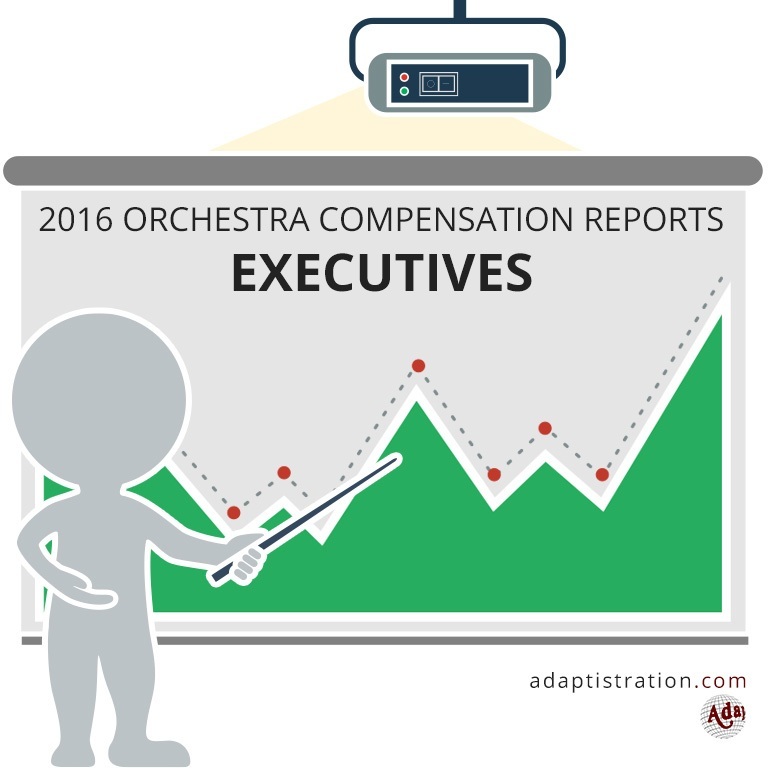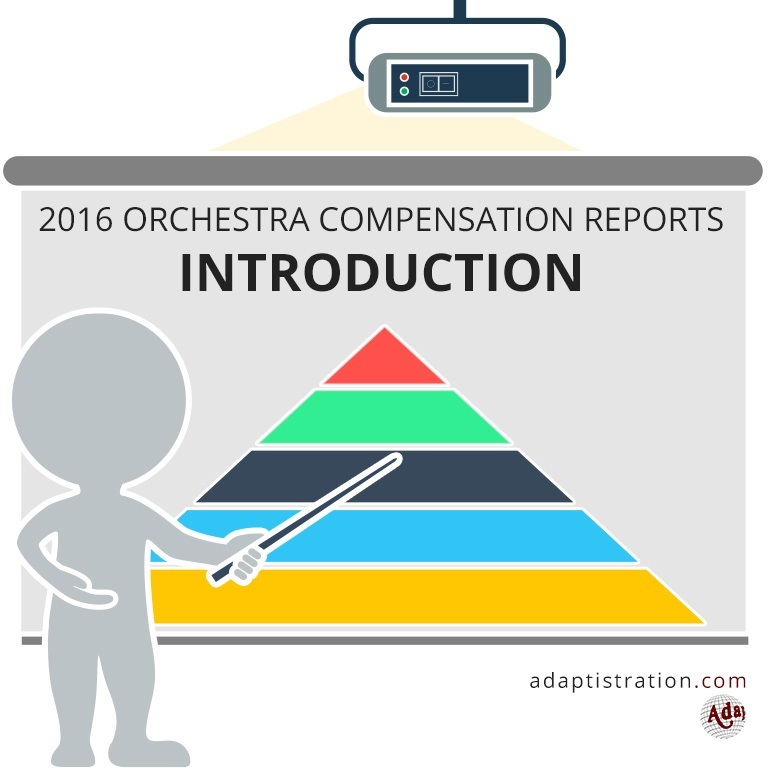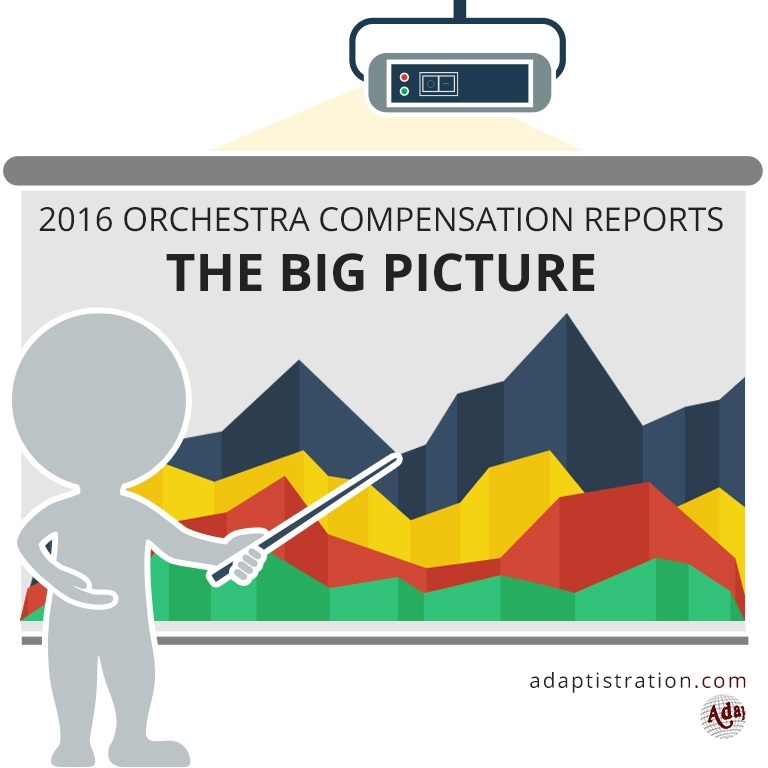By the onset of the 2010/11 season, the field was amidst the beginning of the worst austerity driven labor disputes for the last half century. Collective bargaining agreements were being reopened in order to incorporate concessions designed to forestall financial collapse and when stakeholders were unable to reach mutually agreeable terms, vitriolic public disputes erupted, oft accompanied by prolonged work stoppages. Nonetheless, the average orchestra executive experienced a 5.32 percent increase in compensation.
The Data
![]() In order to provide information that is as accurate as possible, data from the 2010/11 season is gathered from the following sources:
In order to provide information that is as accurate as possible, data from the 2010/11 season is gathered from the following sources:
- Executive compensation figures were obtained from their respective orchestra’s IRS Form 990 for the 2010/11 concert season.
- Total Expenditures were also obtained from each respective orchestra’s IRS Form 990 for the 2010/11 concert season (due to their relationship within a larger performing arts structure, Total Expenditure figures for National Symphony and Atlanta Symphony are unavailable).
Adaptistration makes no claim to the accuracy of information from documents compiled or reported by external sources. If you have reason to believe any of the information is inaccurate or has changed since reported in any of the above sources and you can provide documentation to such effect, please feel free to submit a notice.
What The Data Doesn’t Show
It is important to remember that the numbers shown do not always convey a complete compensation picture. For example, an executive director may have had a large increase in salary due to a severance or deferred compensation package owed when the position was vacated. Additionally, the documents used to gather data do not indicate how much of the season an individual received a salary. As such, the cumulative compensation may artificially inflate annual earnings. Conversely, reported figures may not reflect bonuses or other incentive payments, therefore underreporting what executives may actually earn. As such, the cumulative compensation executives may or may not be more than what is listed.
If you’re curious about exactly how much of a difference can exist, the Philadelphia Orchestra bankruptcy proceeding shed a sliver of light onto the river of unspecified compensation executives can garner by way of perks and benefits. Details were reported in an article published on 3/2/2012.
For additional details about any individual executive’s compensation in any given season, you should review the respective IRS Form 990 for any statements, notes, and/or addendums provided by the organization to explain compensation abnormalities.
2010/11 Season Executive Compensation
[/tab] [tab title=”Total Expenditures”]
[/tab] [tab title=”Top 10″]
Top 10 Earners
- Los Angeles Philharmonic: $1,602,228
- New York Philharmonic: $887,401
- Toledo Symphony: $772,099
- Philadelphia Orchestra: $768,271
- Boston Symphony: $587,514
- San Francisco Symphony: $511,923
- Chicago Symphony: $494,608
- Cleveland Orchestra: $493,895
- Dallas Symphony: $444,072
- Saint Louis Symphony: $419,625
[/tab]




Toledo?
You beat me to it Raymond. That seems crazy out of line. Drew, do you know if there are circumstances that surround Toledo’s number that explain it?
According to the 990 form, it appears there was a large one time payment in addition to the annual salary and if I am not mistaken, I believe that was the final season for their long time executive, William Bell. If that’s accurate, then the additional payments are likely part of some form of severance, benefit conversion, and/or deferred compensation package.
Freudian slip, Drew. Bill Bell was a tuba player – I’m afraid his compensation was unlikely to be at that level. BOB Bell was with the Toledo Symphony for over 50 years starting as a percussionist and finishing with many years as a very successful CEO with a uncanny sense of what his community would and could support.
Freudian slip indeed and thanks for catching that Henry! And for those unaware, I am a tuba player, hence the source for the switch.
Holy Toledo indeed.
Typical American farce–the management takes the money, the people who actually do the work(and have some special skills) get screwed. Management is a non-skill. Anyone can manage an orchestra, Hardly anyone can play the French horn really well. American business has committed suicide by paying managers a lot(noticed how nothing is made in the USA any longer?) Orchestras are doing it ,too. 1.6 million to the manager of the LA Phil. What a sick joke.
I think this is an extreme response Robert; although I understand where a visceral response such as this comes from it is important to remember that successfully managing an orchestra is far from easy and a successful executive deserves to be compensation in accordance with his/her success just as the remaining staff and musicians do. At the same time, it is certainly fair to examine the conditions for evaluating and assigning compensation and for stakeholders, having the information is the first step toward determining if the institutional leaders for their respective orchestra is deserving. To that end, transparency promotes accountability, which is a key component to building an institution that maximizes potential, provides a satisfying workplace for all the employees, and advances the art form.
Well, it is extreme all right because the situation is extreme. America has created for itself–with a lot of help from CEOs and their minions, the illusion that management is what deserves big payoffs and labor deserves very little. Everyone knows this is true. But no one seems to be able to do anything about it. I know a lot of MBAs, Almost any of them could be plopped into a CEO position and do fine. There is a little skill, but not much. On the other hand, most of them are not making anything like CEO salaries. Orchestras are not as bad as other businesses. but the trend is there. It is just stupid to pay an orchestra manager 1.6 million dollars. This is more than any musician except the conductor makes. It is outrageous overpaying. Everyone knows this. It is just that the CEO club has sold this model. The President of the University of California makes more money than any faculty member, even the Nobel Prize winners etc. This is an abuse of the public’s money–and in the end, it is ALL the publics money. People do not like this. They just do not know how to stop it. Managers think they are important. But they really are not. The LA Phil was the same (good) orchestra after Fleischmann as during Fleischmann. He thought he was important and he got himself paid a lot, but he was not important at all. Management people are servants. The real work is done by the musicians(and the faculty at universities and the workers in businesses).
I have no problem with high level managers being well compensated (to a point) as long as they are successful doing their job. In my view their job is to generate enough income so that the organization can support the very best orchestra possible, and that means paying musicians and support staff competitive wages.
If musicians and staff are being asked to take pay cuts and reduction in numbers, then the CEO is failing at the job they are paid to do. In the real world (for profit corporations) CEOs who fail in their job get sacked, not raises.
You wish! In the business world , executives who bankrupt companies get huge “separation packages” and go their merry ways to other companies, leaving behind defunct pension plans and fired employess. What world do you live in? Check out what happened at United Airlines when they went bankrupt. (I know this directly–I almost bought a house from a United pilot who had had his pension dumped and could not longer afford to live where he had been living for that reason–he had to cash in his equity to survive. Not something that happened to the executives). It is one thing to be screwed. It is another thing not even to know you are being screwed.
Robert, your point is well taken. Sadly.
However, I do stand by my point that if upper mgmt is doing a good job, and the orchestra is thriving, they deserve to be paid well (again, to a point). If the orchestra is not thriving, the CEO should not be getting a raise.
I’d gladly pay $1.6 million a year to someone who would make the Minnesota Orchestra as attractive and dynamic an institution as the LA Philharmonic.
It’s simply not true that anyone can manage an orchestra. Look at Michael Henson.
But it was not the management that did this. Salonen got it going, Dudamel kept the
fires burning. Management had almost nothing to do with this. Of course management can mess up. But it is not necessary to pay huge salaries to get people that won’t mess up. This is the big illusion. When a company does well. everyone says wow that CEO was worth the big bucks. When the company goes belly up and the CEO takes his “separation package”, everyone says of oh well it wasn’t his fault. One wonders if the people writing here follow what goes on in business in general at all.
Here’s the difference – mgmt at LA obviously let their conductor (and music director, I’m assuming) have lots of rein to do these things. In contrast, the MOA mgmt basically wants to have total control over EVERYTHING.
I’m thinking that hiring not-top-shelf musicians as orchestra managers isn’t a good idea (no names here). In contrast, didn’t the Milwaukee Symphony hire one of the musicians as CEO on Edo De Waart’s recommendation, and they seem to be very harmonious. I’ve talked to a former board member who is very pleased with the results, as well as several supporters/donors who feel the same way.
I think orchestra CEO and board performance can be evaluated rationally. This should include “big” personnel decisions (music director, players, programming, financial management, endowment growth and performance, marketing, fund raising, operations, community and audience relations, board composition and management), plus the actual results of these activities. Also a creative vision for what the orchestra and organization will be working toward. Also the ability to create and reinforce a work environment and culture that is effective and builds loyalty. When things are not going well this also includes the ability to fix the problems, which often takes stronger judgement and leadership skills. When these are done well, and if you can identify particular actions that led to good outcomes, then high salaries can be easily justified.
I very much doubt that Deborah Borda is the only CEO who could have managed the LA Phil to its present level (meaning very good artistically and outstanding financially) , but she has been successful with multiple orchestras and has not screwed up anywhere.
Of course, as one from Minneapolis, I keep having to come back to the fiasco with the Minnesota Orchestra. I look at the criteria above and do not see any obvious strengths with Michael Henson other than the ability to gain board support. If you are going to take the risks that Henson and the MOA board did in trying to completely change their relationship with the orchestra musicians, then you had better win and win quickly, and if not you had better have a plan B. If you don’t know the risk you are taking, then maybe you shouldn’t be in an executive position.
Part of the justification for generous executive salaries is to buy the loyalty of valued employees.
Major league baseball teams at this time of the year place some players on “waivers” either to get rid of them or more often to get a sense of their value in the market. I think it would be useful for the MOA to put Mr. Henson on waivers to see if any other orchestras with open positions would pick him up. Not likely in this country, even if the board chair and the author of the orchestra’s strategic plan were thrown in to sweeten the deal.
Obviously there was no Plan B. And Henson’s past experience managing orchestras isn’t all that lengthy, which is why I am wondering why he was hired. Hmmm . . . .
The LAPO has a long history of good management, under Ernest Fleischmann (who was evidently a real SOB but an outstanding manager) and now under Borda. The size of her compensation is a little mysterious, considering that Mark Volpe in Boston and Brent Assink in San Francisco make 1/3 of her salary. Volpe and Assink have both done a superb job of keeping their orchestras financially sound, by increasing the size of their orchestras’ endowment during some very tough economic times.
I’m no defender of CEOs, but being an orchestra CEO is a really tough job. Ideally, you would have fabulous people skills, both for fundraising and for leading your board in the right direction while giving them the impression that they are leading. Also, you have to have an understanding of numbers and business and a creative vision that works for both the art form and the public. In my experience observing 6 or so CEOs, noone has it all, and you have to hope that either the organization can cover for them or that they are modest enough to know their limitations and delegate.
Good management is noticeable mostly in its absence.
Can anyone manage an orchestra? I suppose they could try. Do it well? That’s another story.
OK, I have a beef. The chart at face value is alarming. The executive pay listed in the locked out Minnesota Orchestra makes me wince knowing that their players are currently collecting $0 but behind the numbers is an even more troubling trend. Non-profit boards increasingly are beginning to structure arts organizations after the model of their own for profit companies. Just as in industry, devaluation of the humanity which creates the product, and widening executive to laborer income disparities, are rearing their ugly heads in our business as well.
When searching for any type of senior management, you of course want to attract a great candidate, but where do we draw the line? As musicians (labor), it is very difficult for us to make the argument with boards that the corporate structures in which they work, do not work in the arts. Avoiding discussion of the obvious inequities in corporate America, how do we tell a CEO of a corporation, whose position and inflated salary allows him the ability to serve on an arts board that an arts executive’s value is not equivalent?
To a board, there when there is an executive opening, it seems that this is the most vital investment to sustain the health of the organization. Bidding wars, headhunters and consultants to attract a prestigious figurehead is par for the course in the corporate world but can be an absolutely devastating squandering of limited resources in the arts. In both worlds, this is often done with bewildering ignorance of the plight of the laborer struggling to make rent.
In certain ways, we the musicians are somewhat culpable. For instance, the average orchestral musician is well dressed, well spoken, has a high degree of education and a cultural awareness formerly associated only with the elite. We perform in tuxedos and formalwear (few know how long we keep some of this concert dress in service) and when our boards interact with us on a personal level, they can get a false sense of parity within social strata. Conversely, in an effort to show gratitude and maintain support for the orchestras in which we are the most invested constituency, we are afraid to demand what we really deserve. Remembering shuttling their own kids to piano lessons and youth orchestra rehearsals, our subservience makes us fascinatingly cute peers of their children. How many times have we been asked “But what do you do for a LIVING?” “Yes, but what is your real job?”
Performing musicians are not the only ones to suffer. Those choosing to work within arts administration are most often highly trained former musicians themselves. Especially as they begin their careers, dedicated staff work endless hours beyond the workday and through the weekends for pitifully small salaries, because they too passionately love music and solemnly believe in the importance of music to our society.
I recently observed the following scenario in a small regional orchestra which plays ~10 weeks/year. From the looks of some of these figures, it is representative of priorities throughout our industry. The average member of this orchestra makes about $4,000 annually. Many staff work year round for wages which could not bring keep a small family much above the poverty line. Musician and staff pay was frozen, some for half a decade, with a skeleton staff working overtime to keep the ship afloat after a steady office exodus to better employment opportunities.
When faced with vacant executive positions, even with the ship piloted admirably by a small but dedicated staff, alarm bells rang and blood magically appeared from what staff and musicians had been told was an utterly barren stone. Suddenly, while educational concerts were cancelled and musicians were being asked for yet more seasons without even a token increase, huge investments were made in ineffective search firms, executive courtship visits, consultants, board expense accounts and commitments to bolster the salaries of un-named and unproven employees yet to be hired.
Where was this healthy six figure investment before? Why does the allure of a new Messiah warrant such great investment in a roll of the dice which could end up being a dud? Why the ambivalence about the humanity which has weathered the storm and is still committed? Why not invest in and promote from within the organization those who already possess the institutional knowledge and have proven their dedication to the mission to gain traction for an already moving train instead of starting from a dead stop anew?
This mentality was so sadly, but accurately, described by a mentor as “collecting baseball cards”. Questioning why an already legendary player in a top orchestra was not promoted to the principal spot vacated in his section, he was told “They already have Johnny.”
So, back to that chart. It illustrates executive pay vs the total budget of the orchestra. Especially when viewed through the lens of the trying economic times of 2010/11, when so many collective bargaining agreements around the country got clobbered, any increases are suspect. However, those of us in the business can also look at those numbers with a good basic understanding of what the average player makes in those orchestras. This is where the smaller orchestras show the greatest income disparity between the executive and labor.
How can we ask a potential donor in good conscience to “support your local orchestra” when even the board of directors would rather invest in anything but the people who create and support the music? What happens to the artistic integrity of the orchestral product we all hope to promote with a demoralized workforce? How effective is a staff which feels under-appreciated in promoting and supporting the orchestra?
Do we want inspired and passionate executives to lead our organizations? Of course, but at what cost? Orchestras earn zero revenue selling tickets to watch an ED do his job and it is the experience of an orchestra on stage which generates the contributed income. Let’s get our priorities straight.
Those are all good questions and exactly the sort of topics stakeholders should be discussing at their own institutions and along with the cost issues are those of accountability.